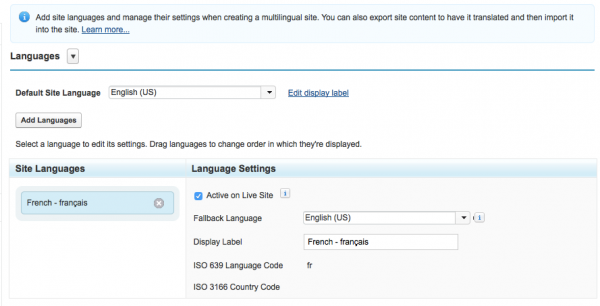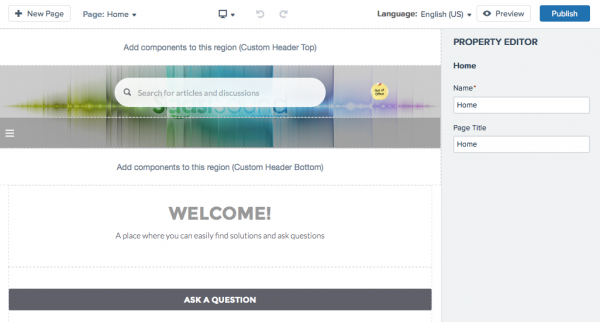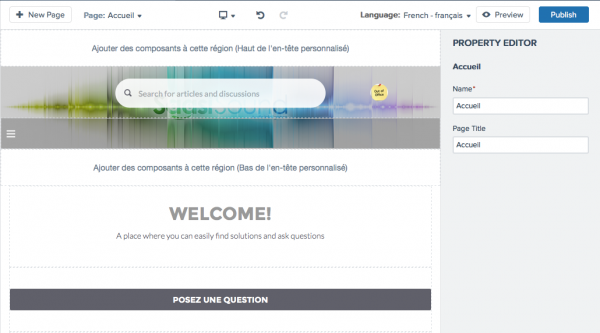As a Salesforce consultant, I rarely expect my French major to come in handy. Today, I put it to good use as I went to test out translation features in the Community Builder, known in French apparently as the “Générateur de communauté”, from inside the Winter ’16 Napili template. Here is what I learned:
You can translate template-based communities into many other languages.
 To do so, go into the Site.com Studio and select the languages you want in the Site Configuration from the following options:
To do so, go into the Site.com Studio and select the languages you want in the Site Configuration from the following options:
- Chinese (Simplified)
- Chinese (Traditional)
- Danish
- Dutch
- English
- Finnish
- French
- German
- Italian
- Japanese
- Korean
- Norwegian
- Portuguese
- Russian
- Spanish
- Swedish
- Thai
Once additional languages have been enabled in the Site.com Studio, you will see a language picker appear in the Community Builder toolbar. By toggling from English to French, I am able to update the properties of the pages and lightning components to be in French. If I toggle back into English, I see the English version of those pages and lightning components. For example, I can rename my home page to ‘Accueil’ and the ‘Ask a Question’ button to ‘Posez une Question’. If you are building a community in a language you do not speak, expect to create a list of all labels to translate and pass it to a translator.
It is recommended to create one community per language.
While you can translate all of the metadata (labels, topics, moderation criteria), if you mix languages in a single community, the data itself (e.g. conversations being had by the community) does not translate. This can make for a poor user experience. For example, if someone posted a question in Japanese, a language I regretfully do not speak, I would see their post in the community but not be able to make sense of it. Instead, build one community, clone it to create one for a different language (learn how in my last blog), enable the desired language in Site.com and then translate the template’s metadata. By having separate communities, each moderator has a unique place to manage their topics, recommendations, reputation levels and moderate the conversations happening in their community. It also gives flexibility for regional variation in layouts, images, topics and subtopics, data category access, etc. You may use different imagery to appeal to an audience in Japan than in the United States, for example, or may not offer the same products in all regions.
If you have good reason to create one community for multiple languages, it is definitely possible to do but takes a few more steps to setup. You will need to:
- Translate topics in the translation workbench
- Translate reputation level names in the translation workbench
- Translate user messages for moderation rules in the translation workbench
- Translate the navigation menu in the translation workbench
- Use a Visualforce email template to welcome new Community Members in their native language
- Create a custom channel for each language to allow community managers to allow you to target recommendations to users in their language. You’ll need to write code to add new users to the channel through the API.
Other things to remember if you are thinking of doing a single community for multiple languages:
- Each community sends the welcome email from a unique email address
- Each community sends the Chatter email with a single company logo and single, mailing address in the footer
- Users who have not logged in will see the community’s default language upon arriving at the community and can use the language picker to change into a different language. So if a Japanese user navigates to your community that is translated into English and Japanese, but the site’s default language is English, they will see the English version of the community and can switch over to Japanese using the language picker. Once a user is logged in, they will see the language indicated on their user record and the language picker is no longer visible.
Have other questions on translating your community? Post them here as comments!



Hi,
When I try to translate my community items, the labels (of buttons and text in search boxes – e.g. “find articles and discussions”) remain the same in all languages. E.g. when I translate to French, the french labels are shown when I switch to English and vice versa.
Any ideas?
Thank you.
I saw your second comment, so glad to hear all is now okay!
Hi Kara,
Great post on the translation features in the community. I am looking into creating a ‘section’ on the community homepage where our customer service department can easily enter some updates / alerts for the customers in their language. I started with a rich text area which seems great for an easy update, but this area is not translatable.
Do you perhaps have a suggestion on how to make a translatable / language specific text section appear on the homepage?
Hi Inge,
That is a tricky one; if you have one community per language, this isn’t an issue. If you have one community translated into many different languages, you are right that you cannot translate the rich text area. You might use a custom object that has a language attribute and rich text area, and pull that data in through a lightning component, but that’s not really ideal since you cannot then manage content from inside the community builder. Depending what messages need to be shown, you might be able to use recommendations and target those recommendations to certain audiences based on language, but they are not one in the same I realize. I actually recommend that you ask this to the product managers on the Success Community; you should have their formal recommendation within a day as there may be a new feature out that would love this. I know of some things on the road map that might be useful for this, but I’m not sure when they will be released.
Hi Kara,
Is it possible to change the Navigation Menu to a different language in our Community.
I have translated in the translation workbench but it is not pulling through to the Nav Menu in the community.
Many Thanks
Hello Kara,
Great post.
I am trying to use a single community for 2 languages (EN & FR), i am able to find the options to translate most of things, but unable to find how i translate Profile headers. I tried that exporting language.xml file from site.com but all in vain.
Here is the link to the salesforce community that has more info.
https://success.salesforce.com/answers?id=9063A0000019Ta0QAE
Looking forward to your reply
Thanks
Rohit, certain items are automatically translated by Salesforce and cannot be overridden by you in the builder. For the profile drop-down in the upper right-hand corner, that should be translatable from inside the builder. In edit mode in the builder, click on the profile icon and it should expose the configurable label options there.
It sure is! You just need to go to the translation workbench under “Navigation Menu Item” and translate things there if you have multiple languages inside a single community.
Good stuff (as usual) Kara! The multilingual features in Community Cloud often go under appreciated, so it’s good to see you featuring them.
One major caveat though: we at Salesforce generally do not recommend creating a community per language. While we know that Chatter post content is not translated, that’s intentional: putting posts in multiple languages can increase the signal-to-relevant-noise ratio in that group. So most community pros will structure their community with a main set of groups that facilitate cross-country communication (e.g. Our Products) and others that are specific to a region (e.g. Latin America).
Each community you create has its own Chatter network, its own set of topics, and has some administrative & management burden. So creating multiple communities to serve highly overlapping audiences may create a balkanized community feed, and may create more administrative burden than is necessary.
Hi Kara,
This was very helpful. I was hoping you could help me with my questions here. With the language settings, the standard fields ,labels are translated except for the User posts/Questions. Am i missing some setup? Is this something that we can achieve. Kindly let me know.
Thanks in advance!
Asha